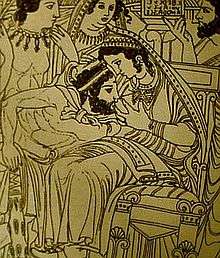Hercle
In Etruscan religion, Hercle (also Heracle or Hercl), the son of Tinia and Uni, was a version of the Greek Heracles, depicted as a muscular figure often carrying a club and wearing a lionskin. He is a popular subject in Etruscan art, particularly bronze mirrors, which show him engaged in adventures not known from the Greek myths of Heracles or the Roman and later classical myths of Hercules.[1]
| Hercle | |
|---|---|
 Drawing of a scene on an Etruscan mirror in which Uni suckles the adult Hercle before he ascends to immortality | |
| Personal information | |
| Parents | Tinia and a mortal woman (raised and adopted by Uni) |
| Siblings | Menrva (half-sister) |
| Equivalents | |
| Greek equivalent | Heracles |
| Roman equivalent | Hercules |
| Egyptian equivalent | Heryshaf |
In the Etruscan tradition, Uni (Roman Juno) grants Hercle access to a life among the immortals by offering her breast milk to him.[2] Hercle was the first man elevated to a godhood through his deeds and Etruscan aristocrats tried to identify with this ascension, as reflected in artwork and literature.
Scenes from Etruscan art
Hercle can be recognized in Etruscan art from his attributes, or is sometimes identified by name. Since Etruscan literature has not survived, the meaning of the scenes in which he appears can only be interpreted by comparison to Greek and Roman myths, through information about Etruscan myths preserved by Greek and Latin literature, or through conjectural reconstructions based on other Etruscan representations.
- Hercle, depicted as a nude youth and carrying his club, presents the winged baby Epeur to Tinia, as Turan (left) and Thalna (right) look on.[3]
References
- Nancy Thomson de Grummond, Etruscan Myth, Sacred History, and Legend (University of Pennsylvania Museum of Archaeology and Anthropology, 2006), pp. 12–13.
- De Grummond, Etruscan Myth, pp. 83–84.
- De Grummond, Etruscan Myth, p. 61.